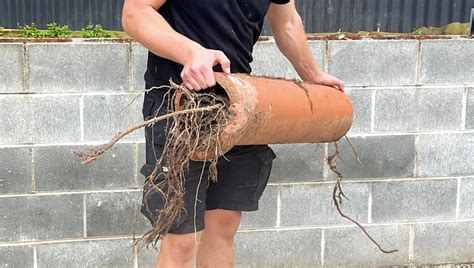Effective Root Removal from Sewer Pipes: A Comprehensive Guide
Tree roots invading sewer pipes are a common and frustrating plumbing problem. These intrusive roots can cause significant blockages, leading to backups, sewage overflows, and costly repairs. Understanding how roots penetrate pipes and employing effective removal methods is crucial for maintaining a healthy and functional drainage system. This comprehensive guide explores various techniques and preventative measures to ensure your sewer lines remain root-free.
Why Do Tree Roots Invade Sewer Pipes?
Tree roots actively seek out water and nutrients. Sewer pipes, often leaking slightly, offer a readily available source of moisture and the decaying organic matter within wastewater provides essential nutrients. The pipes' porous nature or cracks created by age and ground movement further facilitates root intrusion. Roots can easily penetrate even seemingly minor gaps, eventually creating extensive blockages.
What are the Signs of Root Intrusion in Sewer Pipes?
Several signs indicate that tree roots may have invaded your sewer lines. Recognizing these symptoms early can help prevent significant damage and costly repairs.
- Slow Draining Drains: A gradual decrease in drainage efficiency across multiple drains is a key indicator.
- Recurring Clogs: Frequent clogs, especially those requiring repeated snaking or plunging, point towards a persistent problem like root intrusion.
- Gurgling Sounds: Unusual gurgling noises emanating from drains suggest air pockets trapped by root blockages.
- Sewage Backups: The most serious symptom is the backup of sewage into sinks, toilets, or other drains, indicative of a severe root infestation.
- Foul Odors: Persistent sewer odors, even when drains are not actively in use, can be caused by blockages and stagnation created by roots.
How do I know if it's roots and not something else?
Differentiating root intrusion from other causes of sewer line clogs requires professional assessment. However, recurring clogs after cleaning, slow drainage across multiple drains, and the presence of roots near the sewer line are strong indicators of root-related problems. A plumber often uses a sewer camera inspection to confirm root intrusion.
Effective Methods for Root Removal from Sewer Pipes
Several methods exist for removing roots from sewer pipes, each with its own advantages and disadvantages:
1. Mechanical Root Removal:
This involves physically removing the roots using tools such as:
- Root Cutter: A specialized tool sent down the drain line to sever roots.
- Sewer Snake (Auger): While primarily for clearing clogs, a flexible auger can also cut and remove some roots.
Advantages: Relatively inexpensive for minor infestations. Disadvantages: May not be effective for extensive root systems, may only provide temporary relief.
2. Chemical Root Removal:
Chemical root killers are designed to dissolve or kill roots within the pipes. These are typically applied through the sewer cleanout.
Advantages: Can reach extensive root systems. Disadvantages: Can harm the environment, potentially damaging pipes, and may require multiple applications. Always follow instructions carefully.
3. Hydro-Jetting:
High-pressure water jets are used to blast away roots and other debris from the inside of the pipes.
Advantages: Highly effective at clearing both roots and other blockages. Leaves pipes clean. Disadvantages: Can be expensive compared to other methods.
4. Pipe Repair or Replacement:
If the root damage is extensive, or the pipes are severely deteriorated, repair or replacement may be necessary. This is often the most costly solution but ensures long-term reliability.
Advantages: Permanent solution, addresses underlying issues. Disadvantages: Most expensive option.
Which method is best for me?
The optimal method depends on the severity of the root intrusion, the age and condition of the pipes, and budget considerations. A professional plumber can assess the situation and recommend the most appropriate approach.
Preventing Future Root Intrusion
Preventing root invasion is crucial for long-term sewer line health. Here are some effective preventative measures:
- Proper Tree Planting: Plant trees a safe distance away from sewer lines.
- Regular Sewer Line Inspection: Schedule periodic inspections (every few years) to detect root problems early.
- Maintaining Healthy Trees: Healthy trees are less likely to seek water from external sources.
- Repairing Leaks Promptly: Fixing any leaks in your sewer lines promptly eliminates the attraction of roots seeking moisture.
By understanding the causes of root intrusion, employing appropriate removal methods, and implementing preventative measures, you can significantly reduce the risk of sewer line blockages and maintain a smoothly functioning drainage system for years to come. Remember to consult a qualified plumber for diagnosis and effective treatment of root intrusion in your sewer pipes.

